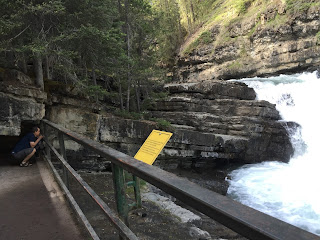We booked our
tour online a few days before. On the big day, we arrived at their office inside Pure Outdoors Outfitters where we
signed waivers and they provided us with warm, waterproof boots and ice
cleats. We hopped on the shuttle and met a friendly traveller named Camille from
Montreal. On the shuttle drive to the canyon, there was no shortage of
wildlife viewing. We drove past a pack of coyotes and saw a huge number of elk
grazing outside the townsite entrance. With the bears in hibernation, it was
strange for me and Dean to turn off our bear awareness, which has been deeply
ingrained from bikepacking and backpacking.
We arrived at the 5th
Bridge entrance, stepped off the bus and took in the lack of view. The mountains were hidden behind clouds and snow. We put our ice cleats on and entered
the canyon.
It was -17°C (1.4°F)
or -24°C (-11.2°F) with the windchill but inside the canyon we were sheltered
from the wind. We hiked Maligne Canyon with our kids in August so it was
bizarre to be hiking on the exposed rocks that were submerged in the river just
a few months before. The island I could only view from a distance in the summer was no longer an island but blended seamlessly into the riverbank.
 |
| Island |
 |
| Not an island |
Our tour guide,
Brody, informed us that the water maintained a temperature of about 5°C (41°F)
where the river flowed out of the ground. We reconnected with the marked trails, soon to
approach a section where the river disappeared under the rocks. Where the
waterfall was once noisy, it merely hissed beneath an intriguing shell of
ice and then disappeared beneath the rocky riverbed.
Framed by the pristine snow and the icy shell beginning to form around the edges, the silly string waterfall seemed more beautiful in the winter. The less it looked like a spider web, the better, I think.
The chain-link had been rolled down on a section of the safety rail. It was our
entry point into the main event. We stepped off the riverbank onto the
frozen river. Even with the ice cleats on, it was very slippery. Note to self: Next
time, bring hiking poles! Brody advised us to walk on the wet ice when possible
because it was grippier. I never thought I would be eager to walk on wet ice in
my life.
 |
| Brody and wet ice |
We were on a gradual incline. It would be seconds of fun sliding down sections on the way back. Before
crossing a narrow, slippery bridge made of skinny logs, we stepped in about 4
inches of water. The warm rubber boots worked great. The chill of
the water didn’t infiltrate at all.
The
canyon began to narrow as we approached the 4th bridge. I couldn’t
believe we were standing where it would have been impossible last August.
We
arrived at the first of the towering falls, in awe of its span and the
beautiful blues.
Something
about the mountains brings out the Gollum in Dean.
 |
| Precious waterfalls at Johnston Canyon |
 |
| All-weather Gollum at Maligne Canyon |
 |
| Gollum Vision |
We
got to explore behind another waterfall.
 |
| His view |
 |
| Her view |
 |
| Interior |
 |
| Exterior |
 |
| Moving on |
I noticed similarities to Upper Antelope Canyon [located in Page, Arizona, 2352 km (1463 miles) away]. We toured it on the way home from the Tour Divide in July. I was fascinated with how similar forms could be found in such different places.
One was carved out by the Maligne River in the Alberta Rockies and the other by flash
floods in the Arizona desert.
We stood on a layer of ice and snow at one and sand in the other.
A chockstone was wedged between the canyon walls at Maligne and a log swept away by floods lodged in the other.
The technology faced some challenges with the freezing temperatures. Dean stopped
to change the batteries when his camera died but the batteries were fine. Water dripped onto the lens and froze in the camera. He
switched to his phone camera and was able to take one picture before the cold took it down too. My phone later tapped out at Athabasca Falls even though the battery life was at 60%. We made sure to store them in inside pockets to warm them up.
 |
| Changing Batteries |
 |
| K-mart pose |
We
had reached as far as we could go. I took so many pictures of the last frozen
waterfall with this nagging feeling that I might miss something. Even as the tour
group started to walk away, I was hesitant to leave until I got the picture just
right. It wasn’t until Dean stepped into the frame that I had found the shot I was
looking for. It encapsulated everything I was hoping for on this adventure:
exploring with my other half and discovering new, beautiful places outside.
 |
| From the point-and-shoot |
 |
| Ice Ice Baby |
















